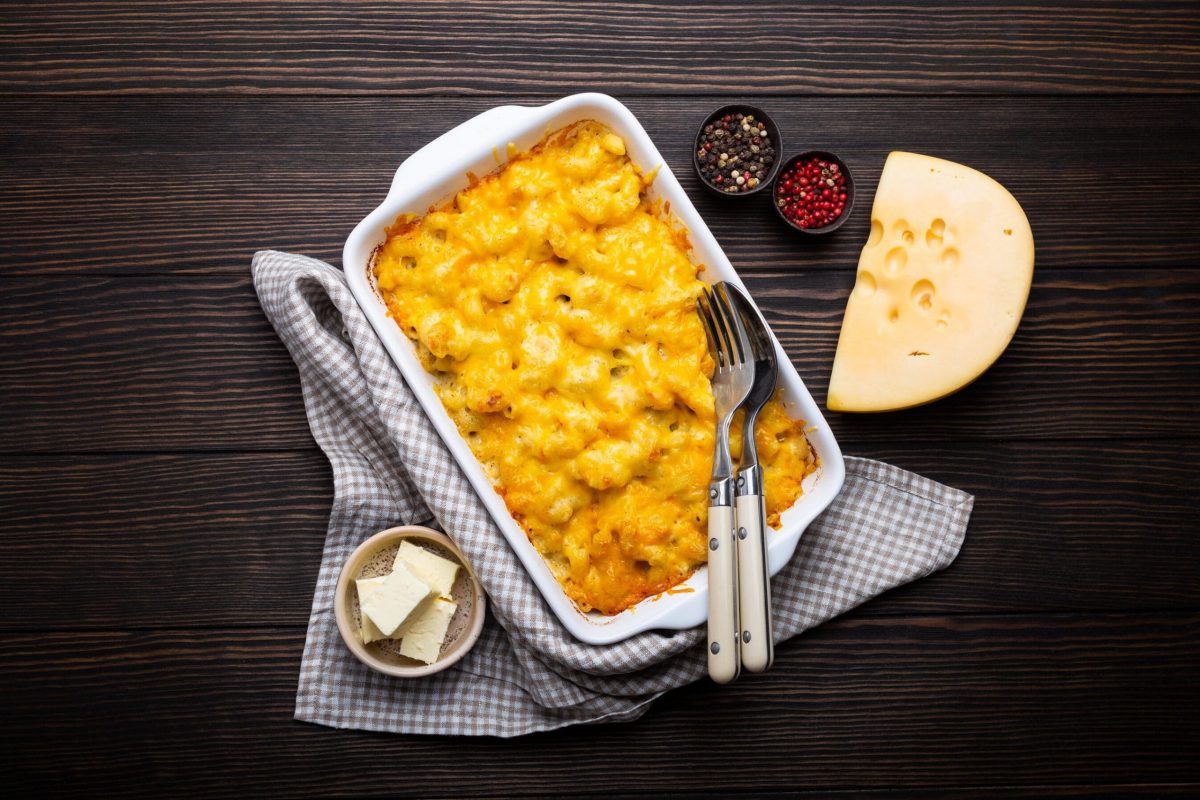How To Thicken Mac And Cheese?
Important Note: When you buy through our links, we may earn a commission. As an Amazon Associate we earn from qualifying purchases. Content, pricing, offers and availability are subject to change at any time - more info.
Last night you ate the most sublime mac and cheese. There was a lot leftover, so you stuck it in the fridge. Now it’s suppertime again, and you want more. You get it out of the fridge and, it’s runny goo! What to do? Well, you have to thicken the sauce. How? Well, remedies abound. And they’re already in your pantry!
The traditional method of thickening mac and cheese combines a roux (cooked butter and flour paste) with milk, added to the mac and cheese sauce. A flour or cornstarch slurry will also thicken mac and cheese. Other thickening agents for mac and cheese include eggs, starches, and dairy products.
Mac and cheese is a simple dish to create, and if made correctly, will last for several days in the refrigerator. However, the radical change in temperature between the oven (or stovetop) and fridge (or freezer) may result in the sauce thinning or even separating.
To reheat, reconstitute, and happily eat mac and cheese that’s lost its composure, all you have to do is follow these
11 Easy Mac and Cheese Thickening Hacks
Using A Roux
There’s a good chance the mac and cheese you want to thicken was made using a roux.
What’s a roux, you ask?
Well, a roux is a butter and flour mixture that’s gently cooked for a few minutes and then combined with boiling milk to create a béchamel sauce, which serves as the base for a cheese sauce (a la mac and cheese).
To thicken mac and cheese using a roux, in a saucepan, melt two tablespoons of butter. To prevent the butter from burning, keep the heat low. Let the butter cook for three minutes to allow its water content to evaporate.
- Remove the butter from the heat. Allow it to cool for two minutes.
- Add flour to the butter. Mix the two to form a smooth paste — aka, a roux!
- Cook the roux gently for three minutes, stirring it continuously.
- Remove the roux from the stove to cool for two minutes.
- Heat two cups milk.
- Add a cup of grated cheddar or mozzarella and a sprinkle of grated nutmeg to the béchamel sauce, and whisk until the cheese has melted.
- Gently warm the mac and cheese to around 300°F.
- Pour the hot, fresh cheese sauce into the warmed mac and cheese and mix well
- Now you’re good to tuck in!
Using Egg Yolk
Egg yolks are classic thickening agents, and they’re right at home with mac and cheese. After all, macaroni is made using flour and eggs!
The hard part is separating the yolk from the egg white. Or is it? You may have a special tool to do this, or you can toggle the egg yolk between the two half-shells. Or, you can use your hands or an empty plastic bottle! Watch this here.
- Once you’ve separated two egg yolks from their whites, beat them well in a bowl.
- Warm your mac and cheese in a saucepan at medium heat — 300°F.
- Pour in the beaten egg yolk and blend well with the mac and cheese so that it thickens the sauce without scrambling.
- Cook for two minutes over moderate heat.
Note: The number of egg yolks you use to thicken your mac and cheese will depend on how much mac and cheese needs thickening. A good rule of thumb is one egg per two large portions.
Using Cornstarch & Evaporated Milk
Cornstarch, aka cornflour, is a ubiquitous culinary thickening agent and a sure-fire fixer of an out-of-shape mac and cheese, particularly when it’s used in conjunction with evaporated milk.
- Pour 1 Tbsp cornstarch into a mixing bowl, add 1/2 cup evaporated milk, and whisk vigorously to a smooth paste, also referred to as a ‘slurry’.
- Heat the mac and cheese in a saucepan and stir in the slurry. Cook for three minutes over medium heat — around 300°F.
Note: Cornstarch and evaporated milk are both purified products and add a dimension of smoothness and gloss to the cheese sauce. However, if neither is in your pantry, use flour and milk, following the same procedure as above.
Using Cheese
If your mac and cheese requires only slight thickening, adding cheese to the heated dish or pot will add flavor and thicken the sauce.
All pasta has a definite cooking time, so reheating will take away some of the texture of the original al dente pasta. Mac and cheese is no exception.
By using American (a processed cheese with a low melting temperature), you can get the necessary thickening and added flavor without the risk of overcooking the macaroni.
Another good way to thicken mac and cheese is to use the starch from a pot of freshly-cooked noodles. The water used to cook the noodles will contain starch from the noodles, which, once mixed into your mac and cheese, along with the freshly-cooked noodles, will help thicken the sauce.
The trick is to place just enough water into a pot to cook the noodles thoroughly without them sticking together. Using a minimal amount of water in the noodle cooking process will generate a starch-rich liquid to add to your mac and cheese.
- Remember to salt the water liberally to flavor the noodles. Stir the pot of noodles every minute as they cook for around ten minutes.
- While the noodles cook, heat the mac and cheese to bubbling point, around 350°F, and remove from heat.
- Strain the noodles through a colander, saving the boiling water in another pot.
- Pour the noodles into the mac and cheese and blend them into the sauce until they’re well mixed with the original noodles and covered in sauce.
- To achieve a smooth blend between old and new noodles (which will add fresh al dente to the mac and cheese), pour in a small amount of the starch-rich pasta water and mix with a big serving spoon to regain a smooth texture.
Note: If the sauce is still runny after this, you can always beat an egg and add to the new ensemble once removed from the stove. The residual heat will cook the egg as you stir it into the mac and cheese.
Using White Rice
Now we move into ‘alternative thickener’ territory. When you’ve run out of all the traditional thickening agents like flour, eggs, and cornstarch, you thankfully have numerous other options to restore your mac and cheese to its former glory.
White rice is a staple starch and, it’s very nutritious. It has a very subtle flavor, which makes it an ideal thickener because it won’t overpower the flavors in the original mac and cheese dish.
- Cook a batch of rice until very soft. Cooking it by steaming it is the best way to preserve all its starchiness, which will be the binding agent in your mac and cheese rescue mission.
- Heat the mac and cheese to medium temperature.
- Place the well-cooked rice into a blender to form a rice puree.
- Spoon the rice puree into the heated mac and cheese.
- Mix well until the sauce thickens. Add more rice puree if necessary.
Using Oats
For the same reasons rice makes a viable culinary thickening agent, oats (yes, good old oatmeal oats) will get your mac and cheese back into shape in double-quick time.
Blend a cup of oats until powdery.
- Heat the mac and cheese in a saucepan and stir in the oats powder.
- Cook over a medium heat for three minutes until the mac and cheese sauce thickens.
Using Potatoes
You can make fresh mashed potatoes or you may have some ready-made mashed potatoes in the fridge or a bag of instant mash in the pantry. Whichever way, mashed potatoes will thicken your mac and cheese with minimal effort.
- Heat the mac and cheese and spoon in the mashed potato. If you’re using powdered (instant) mash potatoes, make that in a separate bowl first and then add it to the heated mac and cheese.
- Cook the mac and cheese (with the added mashed potato) in the oven for five minutes at 300°F. Cook for three minutes on the stovetop at medium heat.
Note: don’t salt the potatoes if you’re making the mash specifically to thicken the mac and cheese. Adding any extra salt at this stage of the rescue process could ruin the enterprise.
Using Beans
Butter beans, black beans, pinto beans, mung beans — in fact, any legume bean can be used to thicken mac and cheese. Naturally, they’ll have to be cooked first or strained from a can.
- Blend the beans into a puree and fold the puree thoroughly into the heated mac and cheese.
- Cook the mac and cheese with its bean puree additive over the stove for two minutes, stirring well. Or, place the new, well-mixed ensemble into the oven for three minutes to get the bean puree to blend and bind with the mac and cheese.
Using Bread
This method may seem outta left-field, but it’s a great way to use that bread that’s about to get chucked out — yes, stale bread!
- Crumb a few slices of bread in a blender. It doesn’t matter what kind of bread, as long as every slice can be crumbed in the blender.
- Put the breadcrumbs in a dish and soak them in warm milk.
- Heat the mac and cheese to medium temperature.
- Fold in the wet breadcrumbs.
- Cook the mac and cheese on the stovetop for two minutes, stirring occasionally. Leave the lid off the saucepan to allow moisture to evaporate and the mac and cheese to thicken.
- Bake the mac and cheese with its bready companion in a preheated oven for five minutes, if al forno is your fancy.
Note: A microwave oven will also activate the thickening properties of the bread mixture in the mac and cheese.
Using Instant Soup
This method of thickening mac and cheese is a cakewalk.
- Heat the mac and cheese.
- Mix 3 tsp powdered instant soup with a ½ cup cold water or milk.
- Add the cold soup slurry to the warmed mac and cheese and cook for three minutes over medium heat – 300°F.
Note: The best instant soup flavors to thicken mac and cheese will be the milder, more neutral vegetable variants, such as cream of vegetable, mushroom, and asparagus.
Using Tapioca Flour
Tapioca pudding is a family favorite across the US, so the chances are good that there’s a box of tapioca pearls in the pantry and a box of tapioca flour (this is the derivative you’ll need to thicken your mac and cheese).
- Heat the mac and cheese.
- Make a slurry with tapioca flour and water at a 1:1 ratio.
- Add the tapioca slurry to the heated mac and cheese and cook for three minutes over a medium heat.
Final Tips
- If your mac and cheese is in a baking tray, transfer the ingredients to a saucepan for more effective sauce thickening.
- It’s always best to warm the mac and cheese over the stove at a medium heat – around 300°F. Preheating the mac and cheese will prevent overcooking the macaroni and potentially burning the sauce.
- Thickening agents form a fraction of the overall volume of the dish, so as a remedial ingredient, they require only a few minutes to cook through while achieving the task of thickening.
- A microwave is an effective way of warming a pre-cooked mac and cheese, making it ready for stovetop thickening.
So, How To Thicken Mac And Cheese?

It’s as American as rock ‘n roll, but it does have its roots in Italy. No surprise then that when things get chilly, relationships inside the mac and cheese fall apart – you know, separation occurs! The solution is to warm things up to at least a medium heat before the reconciliation happens. With these 12 mac and cheese thickening hacks, you’ll get the ingredients in that mac and cheese moving in harmony, while your tastebuds dance right alongside!
























